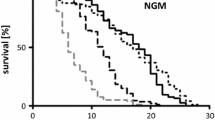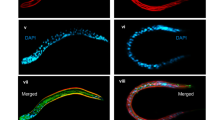Abstract
In this study, we used the nematode Caenorhabditis elegans as a model to assess the pathogenic potential of two species isolated from food, Enterococcus italicus and Lactococcus garvieae, for which few indications on pathogenicity are available. We identified the conditions under which E. italicus and L. garvieae are able to kill the nematode and suggest that the production of hydrogen peroxide (H2O2) by these two bacteria was involved in the death of C. elegans in our model system. The efficacy of E. italicus and L. garvieae to kill C. elegans differed, most likely related to each species’ distinct ability to accumulate H2O2 (4.9 mM and 0.9–1.1 mM, respectively). Genome analysis of both species revealed that the genome of E. italicus contains a gene encoding a NADH oxidase which shows high amino acidic similarity with H2O2 -forming NOX-1 enzymes, while that of L. garvieae contains a gene codifying for a water-forming NADH-oxidase (NOX-2). Reverse transcriptase-PCR experiments carried out in presence of flavin adenine dinucleotide (50 mM) confirmed the presence of the two different genes and likely explains the different toxicity of E. italicus and L. garvieae against C. elegans in our study. The results obtained show for the first time the production of H2O2 in E. italicus and L. garvieae and indicate its toxic effect in the nematode C. elegans.


Similar content being viewed by others
References
Aballay A, Yorgey P, Ausubel FM (2000) Salmonella typhimurium proliferates and establishes a persistent infection in the intestine of Caenorhabditis elegans. Curr Biol 10:1539–1542
Altschul SF, Gish W, Miller W, Myers EW, Lipman DJ (1990) Basic local alignment search tool. J Mol Biol 215:403–410
Aubin GG, Bémer P, Guillouzouic A, Crémet L, Touchais S, Fraquet N, Boutoille D, Reynaud A, Lepelletier D, Corvec S (2011) First report of a hip prosthetic and joint infection caused by Lactococcus garvieae in a woman fishmonger. J Clin Microbiol 49:2074–2076
Ballestriero F, Thomas T, Burke C, Egan S, Kjelleberg S (2010) Identification of compounds with bioactivity against the nematode Caenorhabditis elegans by a screen based on the functional genomics of the marine bacterium Pseudoalteromonas tunicata D2. Appl Environ Microbiol 76:5710–5717
Blaxter M (2011) Nematodes: the worm and its relatives. PLoS Biol 9:e1001050
Borgo F, Ricci G, Arends K, Schiwon K, Grohmann E, Fortina MG (2009) Evaluation of plasmid content and tetracycline resistance conjugative transfer in Enterococcus italicus strains of dairy origin. Curr Microbiol 59:261–266
Borgo F, Ferrario C, Ricci G, Fortina MG (2013) Genotypic intraspecies heterogeneity of Enterococcus italicus: data from dairy environments. J Basic Microbiol 53:20–28
Bradford MM (1976) A rapid and sensitive method for the quantification of microgram quantities of protein utilizing the principle of protein-dye binding. Anal Biochem 72:248–254
Brenner S (1974) The genetics of Caenorhabditis elegans. Genetics 77:71–94
Carvalho Mda GS, Steigerwalt AG, Morey RE, Shewmaker PL, Falsen E, Facklam RR, Teixeira LM (2008) Designation of the provisional new Enterococcus species CDC PNS-E2 as Enterococcus sanguinicola sp. nov., isolated from human blood, and identification of a strain previously named Enterococcus CDC PNS-E1 as Enterococcus italicus Fortina, Ricci, Mora, and Manachini 2004. J Clin Microbiol 46:3473–3476
Eaton TJ, Gasson MJ (2001) Molecular screening of Enterococcus virulence determinants and potential for genetic exchange between food and medical isolates. Appl Environ Microbiol 67:1628–1635
EFSA (European Food Safety Authority) (2008) Scientific opinion of the panel on dietetic products, nutrition and allergies. EFSA J 644:1–44
Ewbank JJ, Zugasti O (2011) Caenorhabditis elegans: model host and tool for antimicrobial drug discovery. Dis Model Mech 4:300–304
Fernàndez E, Alegrìa A, Delgado S, Mayo B (2010) Phenotypic, genetic and technological characterization of Lactococcus garvieae strains isolated from a raw milk cheese. Int Dairy J 20:142–148
Ferrario C, Ricci G, Borgo F, Rollando A, Fortina MG (2012) Genetic investigation within Lactococcus garvieae revealed two genomic lineages. FEMS Microbiol Lett 332:153–161
Fihman V, Raskine L, Barrou Z, Kiffel C, Riahi J, Berçot B, Sanson-Le Pors MJ (2006) Lactococcus garvieae endocarditis: identification by 16S rRNA and sodA sequence analysis. J Infect 52:3–6
Fortina MG, Ricci G, Acquati A, Zeppa G, Gandini L, Manachini PL (2003) Genetic characterization of some lactic acid bacteria occurring in an artisanal protected denomination origin (PDO) Italian cheese, the Toma piemontese. Food Microbiol 20:397–404
Fortina MG, Ricci G, Mora D, Manachini PL (2004) Molecular analysis of artisanal Italian cheeses reveals Enterococcus italicus sp. nov. Int J Syst Evol Microbiol 54:1717–1721
Fortina MG, Ricci G, Borgo F, Manachini PL, Arends K, Schiwon K, Abajy MY, Gronmann E (2008) A survey on biotechnological potential and safety of the novel Enterococcus species of dairy origin, E. italicus. Int J Food Microbiol 123:204–211
Garsin DA, Sifri CD, Mylonakis E, Qin KV, Singh KV, Murray BE, Calderwood SB, Ausubel FM (2001) A simple model host for identifying Gram-positive virulence factors. Proc Natl Acad Sci USA 98:10892–10897
Hatcher MJ, Dick JTA, Dunn AM (2012) Disease emergence and invasions. Funct Ecol 26:1275–1287
Jansen WT, Bolm M, Balling R, Chhatwal GS, Schnabel R (2002) Hydrogen peroxide-mediated killing of Caenorhabditis elegans by Streptococcus pyogenes. Infect Immun 70:5202–5207
Jiang R, Riebel BR, Bommarius AS (2005) Comparison of alkyl hydroperoxide reductase (AhpR) and water-forming NADH oxidase from Lactococcus lactis ATCC 19435. Adv Synth Catal 347:1139–1146
Lee J, Yun HS, Cho KW, Oh S, Kim SH, Chun T, Kim B, Whang KY (2011) Evaluation of probiotic characteristics of newly isolated Lactobacillus spp.: immune modulation and longevity. Int J Food Microbiol 148:80–86
Moy TI, Mylonakis E, Calderwood SB, Ausubel FM (2004) Cytotoxicity of hydrogen peroxide produced by Enterococcus faecium. Infect Immun 72:4512–4520
Penesyan A, Ballestriero F, Daim M, Kjelleberg S, Thomas T, Egan S (2013) Assessing the effectiveness of functional genetic screens for the identification of bioactive metabolites. Mar Drugs 11:40–49
Pfaffi MW (2001) A new mathematical model for relative quantification in real-time RT-PCR. Nucleic Acids Res 29:2002–2007
Riebel BR, Gibbs PR, Wellborn WB, Bommarius AS (2002) Cofactor regeneration of NAD+ from NADH: novel water-forming NADH oxidases. Adv Synth Catal 344:1156–1168
Russo G, Iannetta M, D’Abramo A, Mascellino MT, Pantosti A, Erario L, Tebano G, Oliva A, D’Agostino C, Trinchieri V, Vullo V (2012) Lactococcus garvieae endocarditis in a patient with colonic diverticulosis: first case report in Italy and review of the literature. New Microbiol 35:495–501
Semedo T, Santos MA, Lopes MF, Figueiredo Marques JJ, Barreto Crespo MT, Tenreiro R (2003) Virulence factors in food, clinical and reference enterococci: a common trait in the genus? Syst Appl Microbiol 26:13–22
Sifri CD, Mylonakis E, Singh KV, Qin X, Garsin DA, Murray BE, Ausubel FM, Calderwood SB (2002) Virulence effect of Enterococcus faecalis protease genes and the quorum-sensing locus fsr in Caenorhabditis elegans and mice. Infect Immun 70:5647–5650
Spellerberg B, Cundell DR, Sandros J, Pearce BJ, Idänpään-Heikkilä I, Rosenow C, Masure HR (1996) Pyruvate oxidase, as a determinant of virulence in Streptococcus pneumoniae. Mol Microbiol 19:803–813
Sulston J, Hodgkin J (1988) The nematode Caenorhabditis elegans. Cold Spring Harbor Laboratory, New York
Tan MW, Mahajan-Miklos S, Ausubel FM (1999) Killing of Caenorhabditis elegans by Pseudomonas aeruginosa used to model mammalian bacterial pathogenesis. Proc Natl Acad Sci USA 96:715–720
Tauxe RV (2002) Emerging food-borne pathogens. Int J Food Microbiol 78:31–41
Vendrell D, Balcázar JL, Ruiz-Zarzuela I, de Blas I, Girone’s O, Muzquiz JL (2006) Lactococcus garvieae in fish: a review. Comp Immunol Microbiol Infect Dis 29:177–19
Author information
Authors and Affiliations
Corresponding author
Additional information
Francesca Borgo and Francesco Ballestriero contributed equally to this work.
Rights and permissions
About this article
Cite this article
Borgo, F., Ballestriero, F., Ferrario, C. et al. Hydrogen peroxide-mediated killing of Caenorhabditis elegans by Enterococcus italicus and Lactococcus garvieae isolated from food. Ann Microbiol 65, 833–839 (2015). https://doi.org/10.1007/s13213-014-0924-x
Received:
Accepted:
Published:
Issue Date:
DOI: https://doi.org/10.1007/s13213-014-0924-x




